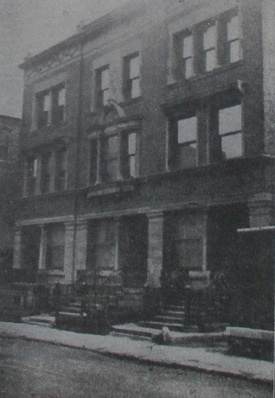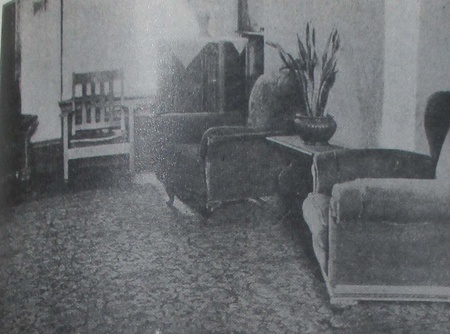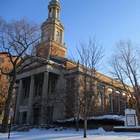In 1917, Shimazu visited the New York Japanese community to secure funding to purchase the property.1 It was variously reported that Shimazu raised $11,0002 or $18,0003, but these donations came mainly in small amounts from friends of the Central YMCA of Chicago.4 Notably, William J. Parker, the General Secretary of the Central YMCA, donated $4,000 to the JYMCI in May 1918. Parker agreed “to deed the property to such corporation as might be formed or selected by the JYMCI, whenever the note secured by the trust deed had been paid.”5 The option to purchase the building was exercised on May 11, 1918.6
The latter half of the JYMCI history was filled with financial struggles because Shimazu operated the organization in conflict with the Central YMCA. The issue was that the title of the property was actually never given to JYMCI, but instead held by the Central YMCA of Chicago,7 and the JYMCI was given the use of the property at a nominal rent, which was probably $1.00 a month.8
The fourth period of the JYMCI was from May 1917 to September 1922. There were no major organizational changes during this period, except for its location, and it maintained its purpose and activities throughout its final days. Shimazu was still on the Central YMCA payroll, earning $150 per month in 1918 and 1919, and $100 per month from 1920 to 1929.9 As an officer of the Central YMCA, he continued to visit Japanese families to recruit new members. He averaged 30 interviews a day, held inside and outside the Institute. Many members were truly anxious about spiritual guidance and needed encouragement. Shimazu visited sick Japanese as well, such as two young men at the Wesley Hospital and the Dunning Insane Asylum.10
Since so many Americans had been sent to war, inquiries at the JYMCI regarding employment of Japanese laborers increased.11 The dormitory business prospered, allowing the institute to charge $8 a week for members and $9 a week for non-members, or $2 a night.12 Members of the JYMCI from out of town were often unable to find a room in Chicago, and complained that the dormitory had become lodging primarily for travelers.13 Social gatherings included an annual Christmas celebration, a picnic by the lake in North Evanston,14 and a hiking trip to the Indiana Dunes, which fifty-six people attended.15
One visitor to the JYMCI in 1931 was Kiyuki Murashima, who visited Chicago with Toyohiko Kagawa, a famous Christian reformer on a U.S. lecture tour. The two men said that they had heard that the Japanese consulate contacted Shimazu whenever they were informed by the police of a death of or an accident involving a Japanese person. In Murashima’s opinion, the JYMCI was taking on consular duties, and a salary commensurate with that level of responsibility should be paid to Shimazu.16
In recognition of their achievements, in October 1922, the Central YMCA approved a recommendation that the JYMCI be admitted as a Department of the Central YMCA of Chicago, which began the fifth period of JYMCI’s history. Via a deed dated December 12, 1922, Parker transferred the property to the Board of Trustees of the YMCA in the amount of $15,000, guaranteeing title to the Board of Trustees of the YMCA of Chicago17. Shimazu reported this organizational change to the YMCA in Japan with the expectation that this would result in a stronger relationship and more cooperation with the Chicago YMCA. The JYMCI at the time had eighteen members.18 Mayumi Hoshino claimed that 1925 marked the peak of Shimazu’s leadership and the JYMCI’s power over its seven years affiliation with the Central YMCA.19 The affiliation lasted until January 1929, when the Central YMCA severed its relationship with the JYMCI.
During those years, Shimazu had to put more effort into seeking funding for the considerable repairs that were apparent on the organization’s deteriorating building.20 The building’s poor condition concerned him enough that he suggested purchasing another building to the Central YMCA. Shimazu went to Japan in 1919 to look for support to solve the JYMCI’s chronic deficit and to raise funds. As a result, members of the Tokyo YMCA organized a support society for the JYMCI.21 The president of the society was Nobusuke Hibiki22 and its office was located in the Tokyo YMCA.23 The Support Society in Tokyo collected 15,000 yen to donate to the JYMCI of Chicago.24
Shimazu also appealed to others for donations, notably celebrities in Japan who had made speeches in Chicago and had stayed at the JYMCI. One of these celebrities was Eiichi Shibusawa, to whom Shimazu had sent a silver plate, when he asked for support for the Japanese YMCA in 1924.25 After a while, rumors spread that Shimazu was very kind to Japanese travelers, but not as generous to poor Japanese students living in Chicago. People spoke ill of the JYMCI, saying that it was not a “young men’s association” at all, but that it catered to middle-aged and older Japanese who were more established, like chefs and chauffeurs.26
Furthermore, Shimazu was arrested on January 19, 1927, along with Seiji Tachibana, publisher of the Japanese newspaper, Dai Nippon, on suspicion of writing bad checks. Although the two were later acquitted and released with help from the Japanese community, the incident “cast a shadow on financial troubles the institute would face.”27 The Central YMCA was quick to decide that continuing the Japanese Department was inadvisable,28 and Parker proposed separating the JYMCI from the Chicago YMCAto Kenji Toda, chairman of the Japanese Department, that same year.29

Nevertheless, Shimazu rallied 169 patrons, including 132 Japanese and Japanese businesses, who collectively contributed $2044.21 toward purchasing a new building.30 He then proposed various ways to reduce the deficit, such as planning more fundraising events, organizing a ladies auxiliary31, conducting a membership campaign, and extending the JYMCA to towns and cities near Chicago32, but nothing could change the Central YMCA’s decision, and their affiliation with the Japanese Department was terminated on February 1, 1929. In April 1929, Houser of the Central YMCA wrote a letter to H. Ichikawa at the Japanese consul, to offer the deed of the property to a properly incorporated organization or the trustees of the Japanese Institute.33
Thereafter, the JYMCI returned to its former status, separate and independent from the Central YMCA. However, it had been so close to bankruptcy that the separation set in motion a series of business management improvements, to free the JYMCI from debt and the constant pressure of soliciting donations. The new JYMCI was expected to have inexpensive and comfortable lodging for travelers and to continue to be a center of social gatherings for non-Christian Japanese Chicagoans.34 During this transition, Shimazu withdrew from management and focused only on religious activities, such as the Sunday morning service and Sunday school in the afternoon, and kept publishing a monthly postcard bulletin to “promote and draw the large interest into our religious work among Japanese in Chicago.”35
The JYMCI made further improvements in their restaurant and remodeled the guest rooms; these changes were made possible with generous financial help from Kanjiro Onishi, a restaurateur in Rockford, Illinois. They hired Tomeno Shintani, a widow with five children from Washington state, to cook Japanese food, and all of these changes were welcomed by the local Japanese.36 Regular activities, such as the Independence Day picnic to Indiana Dunes continued,37 and the JYMCI opened a new Japanese language school in 1931, with an initial class of 13 pupils. Classes were held on Saturdays; during the day from 2:00-5:00, and at night from 7:30-10:00.38

However, this new era of the JYMCI faced more and more difficulties because of the Great Depression. Very few donations could be expected from members of the Central YMCA and rent could not be collected easily from unemployed dormitory residents.39 Furthermore, the circumstances around the JYMCI location changed drastically in 1920s, after the war ended. Shimazu had once warned the Central YMCA that he intended to move the JYMCI somewhere else; he wrote: “they are quite sure this neighborhood will be absolutely disregarded (neglected) by the colored population.”40 In the 1930s, Japanese Chicagoans knew that the JYMCI was located in a “dangerous” black neighborhood, and that some Japanese who had recently visited JYMCI were held up and robbed by blacks.41 It was documented that the aforementioned Murashima (who came to Chicago with Toyokichi Kagawa in 1931), was warned by local Japanese not to walk around alone at night, especially since he was a Japanese traveler carrying money.42
Having failed to incorporate the JYMCI, or to hold on to the property title, did Shimazu lose hope in the future of JYMCI and his work in Chicago? In mid-February of 1934, Misaki Shimazu suddenly resigned from JYMCI and left for Shanghai, China.43 Magojiro Furuya, who Shimazu had replaced at the Japanese YMCA in 1908, had been stationed in Shanghai since early 1920s, and visited Shimazu from Shanghai in October 192344, before his son, Yasuo, was born in Shanghai in 1926. Furuya may have invited the heartbroken Shimazu to come to Shanghai. The two went on to publish a book about Koreans in Shanghai in 1935.
Even though Shimazu left Chicago in 1934, the JYMCI survived to continue serving Japanese Christians in Chicago with new staff members, such as Kenji Nakane from California, who had been the principal of a Japanese language school near Los Angeles45, and Reverend Suekichi Uruno, who came to Chicago in 1937 to lead the church.
In December 1937, the Central YMCA finally took possession of the property and found the building badly neglected.46 After the JYMCI was finally dissolved, the Japanese language school and Japanese Christian church were moved to a different location and managed by the Japanese Mutual Aid Society. They continued serving Japanese Chicagoans until the war broke out in 1941.
Undoubtedly, Shimazu had worked very hard to improve the situation of Japanese immigrants in Chicago for a quarter of a century. In fact, when Robert Cashman of the Central YMCA checked JYMCI’s building, just before terminating their Japanese Department, he left the following account: “Going over the buildings of the Japanese YMCA, room after room from the top floor to the basement [I] was delightfully surprised at what I found. With the exception of certain storerooms and the basement the rooms are clean and in good order. It seemed rather pathetic to me that an organization doing such great good should be so limited in its equipment.”47

The Central YMCA genuinely believed in Shimazu’s mission to help the Japanese in Chicago and undoubtedly offered him tremendous support, including providing him with a paycheck for many years. But it was Hoshino who observed: “The fact that Shimazu was hired as officer in 1911 yet his organization, JYMCI, did not get affiliated with YMCA for another 11 years might strongly suggest the hesitance of YMCA to accommodate a special department for non-white followers.”48 In short, Hoshino implied that it was a form of racial and linguistic discrimination.
On the other hand, the YMCA records reflect that “the history of the Japanese Christian movement in Chicago demonstrates clearly that greater good can be accomplished by segregating the Japanese in a separate department than by trying to assimilate them in various local departments of the YMCA throughout the city. Experience has shown that especially in cases where Japanese people do not readily speak the English language they do not receive the benefits of the local units and generally turn away from them without service, because the Japanese people do not assimilate with the Americans and prosper better as a unit to themselves.”49
Recognizing both viewpoints, social worker Jesse F. Steiner, wrote in his thesis that “in their religious activities the Japanese are seldom associated with American Christians. … Language difficulties and the prejudice against Japanese make segregation necessary.”50 The Chicago YMCA established the Japanese Department in 1922, but also created the “Colored” YMCA in 1909 and the Chinese Department in 1924. Did they aim to segregate, based on race and class, or was it to benefit the Japanese by allowing them to meet without fear of linguistic discrimination and misunderstanding?
At the time, Christianity was a widely shared value and an avenue for assimilation into American society. However, according to a report on Japanese in Chicago studied during the WWII relocation period that was issued in April 1945 under the direction of the Department of Research and Survey of Chicago Theological Seminary and the Church Federation of Greater Chicago, “it is unlikely that complete assimilation of the Japanese in Chicago is possible at present.” The report’s conclusion was based on an analysis of the advantages and disadvantages of four different types of Christian churches; segregated churches, Caucasian churches with a related Nisei minister assigned to a particular church, churches with a Nisei minister assigned to several Caucasian churches, and Caucasian churches without a Japanese minister. Although the report declared that “the churches can reduce the effect of race differences through attempts at influencing people’s attitudes toward these differences,” statements such as “a large contribution may be made by the churches… Methods of achieving (an adequate relationship of fruitful interaction between Japanese and Caucasian culture) must be carefully chosen and earnestly applied”51 resonates with Misaki Shimazu’s years of struggle with the Central YMCA to establish a Japanese Christian community in pre-war Chicago.
Notes:
1. Nichibei Shuho, July 21, 1917.
2. Chicago Tribune, June 17, 1918.
3. Letter from Parker to Hathaway dated January 28, YMCA of Metropolitan Chicago Collection, Box 28, Folder 14, Chicago History Museum.
4. Ibid.
5. Ibid.
6. Memorandum dated Nov 13, 1946, Relations of the Japanese Young Men’s Christian Institute to the Young Men’s Christian Association of Chicago no date, YMCA of Metropolitan Chicago Collection.
7. Ibid.
8. Ibid.
9. YMCA Chicago statement of endowment appropriation to Japanese YMCA, YMCA of Metropolitan Chicago Collection, Box 189 Folder 4.
10. YMCA Report, May 1921.
11. Kaitaku-sha, July 1919.
12. Nichibei Shuho, June 1, 1918.
13. Nichibei Shuho, February 2, 1918.
14. Nichibei Shuho, August 10, 1918.
15. Shimazu YMCA Report, May 1921.
16. Murashima, Kiyuki, “Kagawa Toyohiko no Iyu”, Kumo no Hashira, January 1932.
17. YMCA report-History of the Japanese Institute.
18. Shimazu,Misaki, “Shikago-Dayori,” Kaitaku-sha, August 1921.
19. Hoshino, page 129.
20. YMCA report, May 17, 1927.
21. Kirisuto-sha toshite no Ebara Motoroku Sensei, page 196.
22. Shimazu, Misaki, Beikoku Shikago Nihon-jin Kirisuto-kyo Seinen-kai Raiho-sha Meibo, page 15.
23. Ibid, page 18.
24. Ibid, page 12.
25. Letter from Shimazu to Eiichi Shibusawa dated February 28, 1924, Letter from Shibusawa to Shimazu dated May 16, 1924, Shibusawa Denki Shiryo No. 34.
26. Utah Nippo, March 1, 1926.
27. Chicago Tribune, June 20, 1927.
28. Letter from Parker to Hathaway, dated January 28, 1947.
29. YMCA report dated February 12, 1927.
30. Hoshino, page 120.
31. YMCA report dated February 3, 1928.
32. YMCA report dated August 10, 1928.
33. YMCA report-History of the Japanese Institute.
34. Nichibei Jiho, January 5, 1929.
35. Letter from Shimazu to Houser, May 10, 1929.
36. Nichibei Jiho, October 12, 1929.
37. Nichibei Jiho, July 8, 1931.
38. Nichibei Jiho, October 17, 1931.
39. Nichibei Jiho, March 6, 1932.
40. Letter from Shimazu to Cooke/YMCA, dated February 28, 1924.
41. Nichibei Jiho, May 18, 1932.
42. Murashima, Kumo no Hashira.
43. Nichibei Jiho, January 27, 1934.
44. Shimazu, Misaki, Beikoku Shikago Nihon-jin Kirisuto-kyo Seinen-kai Raiho-sha Meibo, page 23.
45. Nichibei Jiho, March 24, 1934.
46. YMCA report-History of the Japanese Institute.
47. Letter from Robert Cashman to Fred A Grow, Nov 22, 1928.
48. Hoshino, page 128.
49. YMCA report-History of the Japanese Institute.
50. Steiner, page 142.
51. Meyners, J.B., Study of Japanese in Chicago in Relation to Church Organizations, page 12-14.
© 2021 Takako Day






